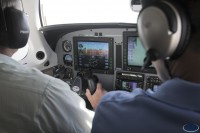AIR Flight Training focuses on detailed, scenario-based Piper PA-46 training for Malibu, Mirage, Matrix, and Meridian pilots. We arm pilots with the knowledge and experience to react in any situation.
————————————
“The healthy and strong individual is the one who asks for help when he needs it.” – Rona Barrett
As pilots, we often struggle asking for help; whether related to flying or not, it seems to be something that we expressly avoid. Evidence suggests there to be a cultural stigma surrounding it, making it a weakness to ask for help.
But, aren’t we taught to always utilize all available resources concerning a flight? Included in “all available resources” are fellow pilots, especially in regards to a safety pilot. When you need it, ask for help from a fellow pilot! When the safety of you, your passengers, and the public is at stake, who cares about a social stigma?
It is appropriate to make use of a safety pilot under any circumstance. Unfortunately, those pilots who do use safety pilots, often only do so for the purpose of instrument proficiency. While that is perfectly fitting, do not hesitate to utilize one on other sorts of flights.
If you’re wanting to brush up on maneuvers and prefer help scanning for traffic, use a safety pilot. Even if you simply desire a second pair of eyes on a standard VMC trip, ask for help from a fellow pilot.
When deciding who to ask to pose as a safety pilot, first review these pertinent regulations:
FAR 91.109(c), No person may operate a civil aircraft in simulated instrument flight unless:
-
The other control seat is occupied by a safety pilot who possesses at least a private pilot certificate with category and class ratings appropriate to the aircraft being flown.
-
The safety pilot has adequate vision forward and to each side of the aircraft, or a competent observer in the aircraft adequately supplements the vision of the safety pilot; and
-
Except in the case of lighter-than-air aircraft, that aircraft is equipped with fully functioning dual controls. However, simulated instrument flight may be conducted in a single-engine airplane equipped with a single, functioning, throwover control wheel, in place of fixed, dual controls of the elevator and ailerons, when:
-
The safety pilot has determined that the flight can be conducted safely; and
-
The person manipulating the controls has at least a private pilot certificate with appropriate category and class ratings.
-
If you are the designated safety pilot for someone under the hood or otherwise, don’t forget that while you aren’t the sole manipulator of the controls, you ARE responsible for the safety of the flight. If an incident or accident occurs, you will be held accountable.
Whether you’re making use of a safety pilot for the purpose of instrument proficiency, simply because you’re uncomfortable accomplishing a flight on your own, or for any other reason, never be afraid to ask for help!

